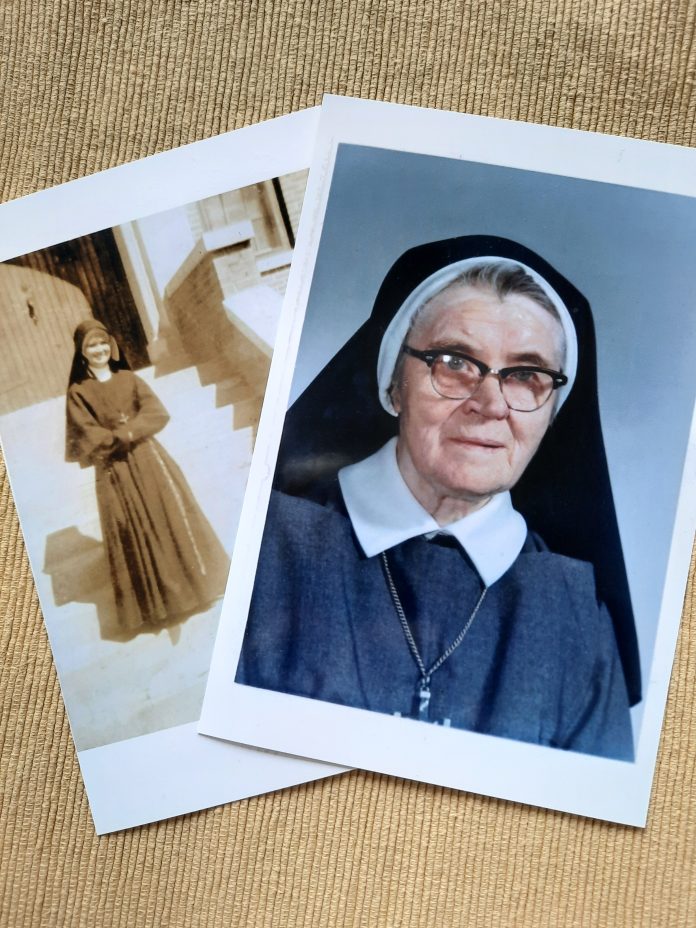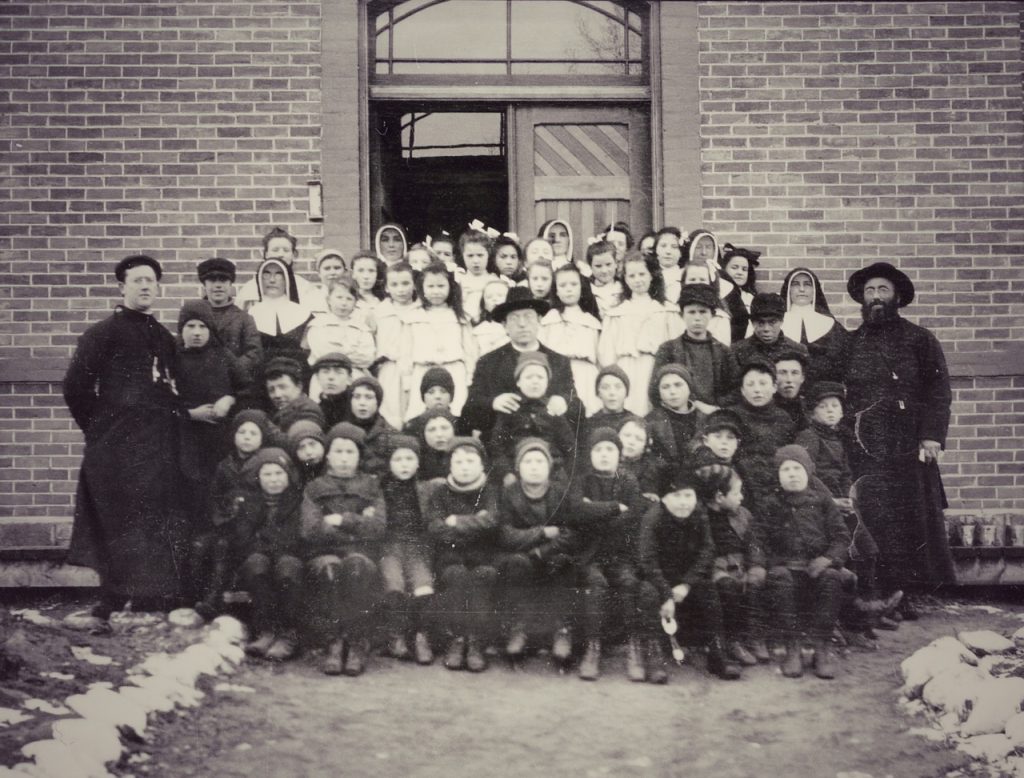
This is the nineteenth in a series of columns about the 70 British Home Children sent to St. Patrick’s Catholic Orphanage in Prince Albert between 1901 and 1907. While all orphanage records were destroyed in the terrible fire of 1947, every attempt has been made to trace the life stories of these dispossessed children through genealogy websites and newspaper databases.
The Giblin / King Children: Misery in the Ghetto
“‘Murder! Mrs. Harris, come and save me!’ I got out of bed and putting on my petticoat went into their room. I said, ‘Mr. King, don’t do that.’; the blood was streaming down his wife’s face to her waist. He got out of bed and knocked me down with his fist. I got up and he knocked me down again and kicked me on the right thigh. He then picked me up and threw me against the bedstead in my own room saying, ‘Lay there.’ I called my granddaughter, age 6, … [who] got a stick and trashed Mr. King with it. I laid on the floor all night [with a broken leg], and in the morning Dr. Fegan was fetched, who ordered me to the infirmary.” Court testimony of Frances Harris, age 68, tenant at the home of George King and Margaret Giblin, Woolwich, Kent, England. – Kentish Mercury, 9 Feb 1894.
Margaret (Flynn) Giblin (abt 1861-1920) had nine children by two different men, four of whom died in infancy or early childhood. The father of five of her children was her husband Charles Gilbin (1856- ), a soldier in the British Army whom she had married in 1882. The other four were fathered by George King, a hydraulic crane operator Margaret left her husband for in about 1888. Three of her children – the youngest – Julia King, Annie King, and Frederick Giblin, were sent to St. Patrick’s Catholic Orphanage in Prince Albert, Saskatchewan, Canada in 1903.
Charles Giblin enjoyed a successful career in the military before his life was irreparably shattered by his wife’s desertion. In 1882-83, Giblin served in Egypt and was awarded the Egyptian medal and the Egyptian Bronze Star. He was promoted to corporal in 1883 and then to sergeant in 1885. Then his life fell apart.
Margaret Giblin left her husband Charles for George King sometime before her daughter Rose King was born in 1888. Charles Giblin deserted the British Army on 20 October 1888, possibly to look for his wife. He rejoined in 1892 and was subsequently tried, reduced to the rank of private, and imprisoned. After his release from prison, Giblin deserted a second time. On 22 June 1895 he was discharged from the British Army for misconduct. His character upon discharge was recorded in his service record as “bad.”
Charles Giblin may have reunited briefly with Margaret during her years with George King. In his later life, her son Frederick claimed he was born a Giblin on 15 August 1892 at Woolwich, Kent, England. His birth occurred between that of his half-sister Julia King (10 November 1891) and his half-sister Annie King (abt 1895). No matter who Frederick’s father was, Margaret was still living with the brutal George King in 1894 as the newspaper story above indicates.
Why did Margaret and George decide to send their three youngest children to Canada in 1903? The 1901 British census shows that George had a job as a “fitter’s labourer” but perhaps his salary was not enough to sustain his family. Maybe grief weighed down on them. The couple had lost three of their children in short succession: 1 year-old Harry in 1891; 4-year-old Rose in 1892; and 1-month-old George in 1901. Perhaps it was simply desperation that caused the parents to send their children away. And finally, it is highly possible that the little ones were taken away from their parents by a rescue society and placed in an orphanage or children’s home until they were shipped overseas.
Julie Baker, great-great-granddaughter of Margaret Giblin, wrote to me on 7 February 2023 that, according to his death certificate, baby Harry King died of Marasmus, “malnutrition occurring in infants and young children, caused by an insufficient intake of calories or protein, which fits with the picture of poverty and hardship for the family.” Julie also found scholarly articles suggesting that the widespread practice of giving children narcotics, especially opium [laudanum], to quieten them was a major cause of Marasmus. “Opium use was rife in Victorian times, as medicine as well as for pleasure,” Julie wrote. “It may explain the violent behaviour of George King and possibly the sudden departure of Margaret?”

The three Giblin children are somewhere in this photo taken at St. Patrick’s Catholic Orphanage after 1906.
Doctors in England reported that the widespread use of opium killed infants through starvation rather than through overdose. Children “were kept in a state of continued narcotism [and were] thereby disinclined for food.” They “shrank up into little old men, “wizened like little monkeys.” “The majority of such children … died before reaching the age of two,” writes Elizabeth Lomax in her article, The Uses and Abuses of Opiates in Nineteenth-Century England (Bulletin of the History of Medicine, March-April 1973), “and those who survived were often half idiotic, with their ‘constitution ruined for life’.” Were Julia, Frederick and Annie also dosed with laudanum when they were babies?
Julia and Annie King travelled to Canada under the name Giblin (likely because Catholic authorities did not recognize Margaret Giblin’s common-law marriage with George King) aboard the Tunisian in May 1903. After she left St. Patrick’s Catholic Orphanage, Julia (1891-1962) entered the Noviate Congregation of Sion in Prince Albert in 1910, entered the profession in 1913, and made her perpetual vows at Prince Albert on 4 September 1924. The 1926 census shows Julia was a nun at the Convent of the Lady of Sion in PA. She was transferred to the convent in Moose Jaw, Saskatchewan in 1939 where, as Sister Gerardina, she served as a lay sister who performed domestic chores. In 1968, Julia returned to England for the first time where she reunited with her oldest sibling, Mary Margaret. Julia died of cancer on 21 November 1970 in Moose Jaw at age 78. She is buried in the Convent of Sion plot at Rosedale Cemetery.
Frederick Giblin (1892-1962) came to Prince Albert a few months after his sisters, arriving in October 1903. He enlisted in the Canadian Army at age 20 in October 1915 at Camp Hughes, Manitoba. He gave his occupation as a shoemaker in Marcelin, Saskatchewan. Frederick served on the front in France as part of the 28th, then the 53rd, Battalion. He found his mother Margaret Giblin, who was still living in Woolwich and listed her as his next of kin in his Army records. After the war, Frederick married Annie Ellen Scott in Holbeck, Yorkshire. He requested to be discharged in England, giving his address as his mother’s home. Frederick and his wife returned to Saskatchewan in 1922, two years after his mother died. He became the storekeeper in the village of Maymont before moving to White Rock, British Columbia where he died on 31 August 1962. Frederick is buried in Veteran’s Plot 379 at the Sunnyside Lawn Cemetery in White Rock.
Not much is known about Annie Giblin / King (abt 1895-1976). In Julia Gibllin’s convent records, Julia gives her next of kin as Mrs. Heppenstall, then Mrs. Weber. It seems she changed her name to Margaret (that of her eldest sister), using the name Margaret M. Giblin on her marriage certificate when she wed Stanley Heppenstall on 2 November 1919 in Brandon, Manitoba. An infant daughter, Kathleen Joyce Heppenstall, died at home in Winnipeg, Manitoba in 1927. Sometime after 1940, Margaret either married or cohabited with Edward Weber. If this is indeed Annie Giblin, she died at age 75 on 3 March 1976 and is buried as Margaret Weber with Edward Weber at Brookside Cemetery, Winnipeg.
Many thanks to Patricia Kelly and Julie Baker in England and Andrew Beaumont in New Zealand for sharing their family information with me.

